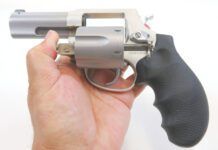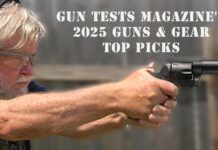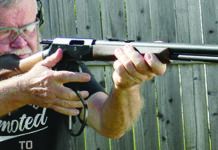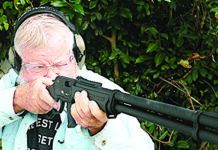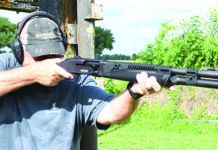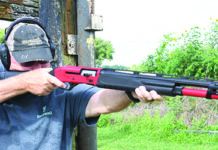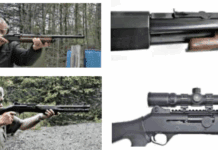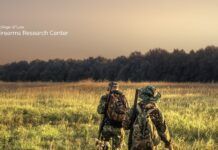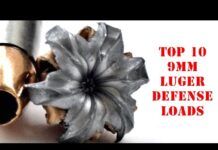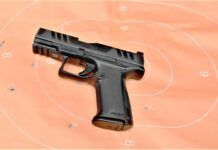The practice of carrying a second gun is nothing new. Pairing a six-shooter with a pistol-caliber carbine or carrying a big service revolver on the hip with a small-framed 5-shot revolver hidden elsewhere are good examples of an effective defensive duo. In this test we looked at two high-capacity 9mm pistols and tried to match them to a pair of smaller pistols of the same caliber.
Our first pair was the $498 Taurus PT 24/7 G2 and the much smaller $483 709B Slim pistol. Both guns utilize double-action and single-action fire. Our second pair featured full-time double-action triggers, but from different makers. They were the $729 Walther PPQ and the very small $490 Diamondback DB9. We hate to spoil the surprise so early in the article, but our shooters werent completely satisfied with any combination of these guns in big/little pairs.
Though its seems like the two Taurus guns might go well together, they displayed very different characteristics that could interfere with transitioning easily between them. Also, as we detail below, we didnt like the Walther well enough to recommend it alone, so we likewise wouldnt pair it with a smaller gun. The Diamondback was painful to shoot, so that nixes it as a pairable backup, in our view.
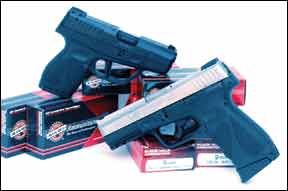
So, instead, we simply evaluated the pistols individually. Since methods of concealment vary with situation or code of dress, we also considered each of the smaller guns for the role of primary gun as well as for backup.
How We Tested
Each gun was tested with three different varieties of red-box new-manufacture jacketed ammunition from Black Hills Ammunition (www.Black-Hills.com). For the bigger guns, we used 115-grain FMJ rounds, 115-grain JHP EXP ammunition, and 124-grain JHP +P ammunition.
The smaller guns were treated to the same ammunition, but we chose to substitute Black Hills 124-grain standard-pressure jacketed hollowpoints for the +P rounds. This is important because Diamondback, along with several other manufacturers of smaller guns, specify that firing +P ammunition will void the warranty. According to SAAMI (the Sporting Arms and Ammunition Institute, Inc.), +P ammunition is loaded to a higher pressure than standards agreed upon by the industry for a given caliber, and they achieve higher velocities as a result. The Black Hills EXP rounds were designed to come as close to the edge of SAAMI specs as possible without violating similar warranties.
Our test procedure included firing from support to determine accuracy under the best possible circumstance. This meant sandbag support from atop the solid wood benches found at Houstons American Shooting Centers (www.AmShootCenters.com). The larger guns were tested from the 15-yard line and the smaller ones from the 10-yard bench. We also did a lot of offhand shooting standing 5 to 7 yards from multiple targets. We found that more sophisticated tests were unnecessary to determine what each gun could do. Heres what our test-team shooters uncovered:
Taurus 24/7 G2 24/7-G29SS-17
9mm Parabellum, $483
Opening the hard-plastic lockable case, we found a black polymer-frame pistol with accessory rail/dustcover and a matte stainless-steel slide. The 24/7 G2 also had ambidextrous thumb safeties that locked the slide as well as the action. In the upper left corner of the case interior we found two pairs of keys. One key fob was black and the other was gray. To the gray key fob were attached an action lock and a small flat screwdriver. The screwdriver was to be used for adjusting the windage and elevation of the low-mount rear sight. (Both the front and rear units were slotted and pinned into place.) The black fob carried an action lock and a punch. The punch was used to remove the backstrap in case the shooter wanted to change grip profile. Three different backstraps were supplied. The fit of each backstrap was seamless, if not undetectable. The supplied driver pushed the solid locking pin far enough to allow the panels to be changed without being separated from the pistol. So there was no fear of losing the pin. The panel marked L actually added more circumference at the web of the hand than inside the hollow of the shooters palm. We tested primarily with the medium-size backstrap in place. Two 17-round magazines were supplied. Both magazines showed loaded confirmation holes for each round plus a brightly colored follower for faster recognition.
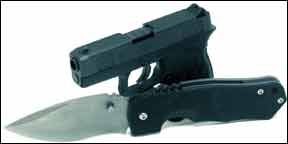
One feature that was invisible to the naked eye was the decocker. Pressing down on either thumb safety safely lowered the hammer for first shot double action. Two more ambidextrous features were the slide stop/release levers and the magazine release. The magazine release worked with a crossbolt action and seemed mushy at times, we thought. Partially loaded magazines were not always anxious to leave the frame, and it seemed like one magazine was more willing than the other. The PT24/7 G2 offered a loaded chamber indicator consisting of a black colored bar located atop the slide to the rear of the ejection port. A loaded chamber caused the bar to rise so that it could be quickly seen as well as felt by running a finger along the top of the slide. There was also a safety lever on the face of the trigger that, when pressed, allowed the trigger bar to operate.
In addition we found that until this lever was pressed, the trigger itself was blocked by a tab that hit the edge of the relief in the frame. A separate firing-pin block remained active until the trigger reached its final stage of compression. Takedown required carefully clearing the weapon because once the slide was retracted about 1/8th inch and the disassembly latches were pulled downward from both sides of the frame, the trigger must be pressed to release the top end. In fact, the trigger must be held rearward until the slide has been moved forward about 0.4 inches. With top end removed, we found that the PT24/7 G2 operated with a two-spring plunger-style recoil assembly. Replacing the top end meant sliding it on to the frame and working it back a forth a couple of times to make sure it is properly connected. But we had to make sure and apply the top end with the slide riding low and tight against the top of the frame. Otherwise, the ejector would not fit through the opening in the back of the slide.
The PT24/7 G2 was a lot of fun to shoot rapid fire, and we were able to holster it with the safety on between runs. But the PT24/7 G2 is not designed to be carried cocked and locked. Put in the magazine, rack the slide, and the gun goes to first-shot double action. Only by firing a shot will the trigger of the PT24/7 G2 transfer to single-action mode.
Our bench rest session was performed single action only except for the first shot of each group. The 9.0-pound double-action trigger was manageable but we liked the single-action trigger a lot better. The 6.5-pound single action trigger presented a brief takeup and little negative interference. Our PT24/7 G2 liked the powerful 124-grain +P hollowpoints best, with groups ranging from 1.8 inches to 2.9 inches across measured center to center. Average size was 2.3 inches.
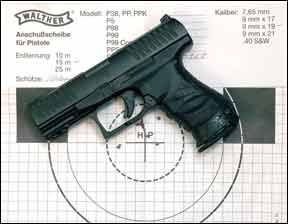
During offhand shooting, we found that once in single-action-only mode (after the first shot), we could easily adapt to the shorter stroke. And we could safely and accurately pick up on the reset point, making for some very fast transitions. We set up an impromptu action test to see what kind of splits (the timed interval from shot to shot) we were getting by using the return-to-reset technique. By this we mean holding the trigger fully to the rear upon ignition and releasing only so far as necessary to reset the trigger. Timed with a flash sight picture, we could really rock and roll with the 24/7 G2. The safety levers were easy to operate and didnt get in the way. In addition, we were able to fire the gun with the strong-hand thumb riding above the safety without fear of accidentally pushing down on the lever and decocking the action. Firing single action only, our splits averaged about .20 seconds per shot, which is worthy of many competition pistols.
Our Team Said: The fast action of the 24/7 G2s SA trigger was remarkable and begged for cocked-and-locked carry. But this would require a redesign or willingness to discharge the weapon and leave the firing line cocked and locked. Wed like to see the magazine release improved; otherwise, this gun appears to be a great value.
Taurus 709B No. 1-709031
9mm Parabellum, $483
Visible similarities between the 709B to the PT24/7 G2 included a smaller version of the adjustable rear sight unit, takedown levers, thumb-operated safety, and the slide release. But in this case, the thumb safety and the slide-release lever were positioned on the left side only. The magazine release also utilized a crossbolt action, but access, as received, was limited to the left side to keep the gun as slim as possible. However, the magazine release could be changed to operate from the right-hand side. The grip did not offer a changeable backstrap, and two sets of keys for the sights and the action lock were supplied. With the 7-round magazine in place, most shooters will be able to get at least some of their pinky on the grip. (A longer 9-round capacity magazine is also available.) The same-style chamber indicator found on the bigger Taurus was in place, but the cocking indicator was absent from the rear of the slide.
The takedown procedure for the 709B was the same as for the PT24/7 G2, and so was the design of the recoil system. But the front sight of the 709B was pinned into place rather than pushed in from the side. Actually, a flathead screw was visible from beneath the slide to secure the front sight. The single-column magazine also utilized a brightly-colored follower for tracking how many rounds were in store. Thanks to removable base pads, the magazines for both Taurus pistols were easy to clean.
The primary differences between the two guns involved ergonomics and trigger. First, the gun was so slim that the shooter could get a lot more finger than necessary across the face of the trigger. Whereas the contact with the pad or the bend of the first joint of the index finger is ideal, we found ourselves working the trigger, more often than not, with the flat between the first and second joint. But since we found it so easy to command an effective grip on the 709B, we were able to shoot accurately even when our technique was not textbook perfect. One reason we felt confident was the consistent trigger. The 709B was actually closer to being a single-action-only firearm than firing from a DA/SA format. Thats because the double-action trigger only comes in to play if a double strike is required. Double-strike capability means if a round fails to fire, stroking the trigger again (or repeatedly for that matter) will deliver additional blows to the primer. In contrast to the DA/SA trigger of the PT24/7 G2, the 709B trigger went directly into single-action mode upon chambering a round and would stay SAO unless a round did not ignite on the first impact of the striker.
We never suffered a failure to ignite or any other type of malfunction, so all shots in our tests were performed using the single-action trigger. From the 10-yard bench, only two groups measured 2 inches wide or larger. Overall average size for all groups fired in our tests computed to about 1.5 inches.
We found the Taurus 709B to be controllable, so even the hottest EXP rounds were not tiring to shoot. Due to its small size, we actually preferred shooting the 709B held in one hand. This could be a plus, in our view, because when fighting in close quarters the support-side hand might be busy wrestling with an assailant.
We didnt find the return-to-reset technique used in the 24/7s action test to be as useful with the 709B. Thats because the greater recoil and smaller sights made it more difficult to be accurate during rapid fire. We found it much easier to coordinate the sight picture with a release that included a slight separation from the trigger. Keeping in mind how much finger was inside the trigger guard, the added moment of relaxation helped prevent de-isolating the trigger finger and mistakenly squeezing the grip in sympathy with the trigger. Typically, this would put shots all over the target. Concentrating on using a separate dedicated press for each shot, we were able to place all eight shots into groups measuring less than 5 inches across from a distance of 5 yards with split times of less than 0.4 seconds between firing.
Our Team Said: The 709B performed quite well. We did notice discoloration on ejected brass that told us the barrel was unlocking prematurely and allowing gas to blow rearward into the chamber. But suitable velocities for each round were recorded, and the 709B was one of the least tiring or abusive little nines weve tried. As far as pairing it with the PT24/7 G2, we think the difference in first-shot modes might make them difficult to match up as a team.
Walther PPQ No. WAP00Q90
9mm Parabellum, $729
The designation PPQ stands for Police Pistol Quick Defense – we dont know where the D went. The owners manual does a good job of listing some of the features that makes the PPQ a fast-action pistol. For one, the rear-sight unit on this double-action-only striker-fired polymer-framed pistol was indeed quite clear. The three-dot system was enhanced with edges angled toward the notch on the rear-sight blade. Windage may be adjusted by turning the click-detent screw on the right side of the sight body. Elevation adjustments could be made by changing the front sight to a different height blade. Alternate front sights were not supplied, but the standard front-sight blade resulted in a suitable point of impact at our test distance of 15 yards. A 15-meter proof target was supplied, showing a 5-shot group that measured just less than 2.0 inches across. The test round used by Walther was not identified.
Another quick aspect of the operation of this 4.0-inch-barreled gun was the slide latch/release levers found on both sides of the frame. They were grooved for better contact, and visually they provided a handsome set of lines sweeping rearward from the center of the pistol.
Takedown was quick, too. Pull down on the takedown latches disguised as panels seated flush with the side of the frame, jog the slide to the rear about 0.3 inches and move the top end forward off the frame. There was no need to press the trigger as long as the action was not already cocked. Recoil was controlled by a flat-wire spring captured over a polymer guide rod.
The full-dustcover polymer frame had a three-groove accessory rail up front. The rail was the proper width to accept every light and laser we had in house, but the more compact units offered a better fit. Walther chose to utilize a Heckler & Koch-style magazine release. This design works off a hinge located at the rear lower corner of the trigger guard. In effect, the lower rear portion of the trigger guard on both sides became paddles. Some of our shooters were able to release the magazine with the strong-hand thumb. Others shifted the gun in their hands and pressed the paddles downward with the trigger finger or with the middle finger.
The alternate grip panels sized small, medium, and large attached in the same way as on the larger Taurus pistol. Drive the roll pin out from its location at the bottom rear of the grip and slide the panel off. In the case of the Walther backstraps, the variation in profile was greater than typically found on such pistols. In our opinion, all three panels were comfortable.
Safety features on the PPQ were limited in our view. The loaded-chamber indicator consisted of a red marking that was designed to be exposed when the externally mounted extractor was pushed outward at the front, creating an indentation to the rear of its pivot point. A right-handed shooter could also feel the indentation with the trigger finger. In our opinion, neither indication was particularly strong. In fact, the red indicator line was not revealed by the mere presence of a round in the chamber. We only found it by manually pushing the rear of the extractor inward with a pick. Aside from internal safeties that go without description in the owners manual, there is a trigger safety hinged inside the face of the trigger.
The actual effect of this safety is the trigger will not move to ignition unless the levered portion of the trigger is compressed. In most cases, we see this as somewhat marginal, as any amount of pressure on the face of the trigger will compress its spring and deactivate the safety. But with the addition of the paddle-style magazine release, wherein a finger searches the trigger guard to release the magazine, this design could be more relevant. However, due to the very light resistance of the trigger (we measured resistance to be about 3.5 pounds with a Chatillon trigger-pull gauge), we became wary of an accidental discharge.
From the bench we were able to shoot our best groups firing the Black Hills 115-grain JHP EXP rounds. Final average measurement for five shots was about 1.6 inches center to center. The PPQ produced 412 ft.-lbs. of muzzle energy on average firing the EXP ammunition. Only the PPQ loaded with the Black Hills 124-grain JHP +P rounds proved to be a more potent combination.
Despite the comfortable grip of the PPQ, recoil and muzzle flip proved challenging. We didnt find accuracy enhanced by any particular method of press during rapid fire, and the trigger was so light we feared using the return-to-reset technique. Much of our concentration when firing the PPQ was taken up by just getting the sights back on target.
Our Team Said: As much as we appreciate a sweet trigger, we were not comfortable with a full-time short-action trigger that required less effort to activate than most competition-ready pistols. Despite the comfortable grip in all three variations, we found it very difficult to fire the PPQ quickly and accurately offhand.
Diamondback DB9 9mm Parabellum, $490
If our other guns had operational features reminiscent of the Glock pistols, then the Diamonback DB9 borrowed the most in terms of appearance. Takedown of the DB9 was by slide manipulation and pull down latches, much like the Glock, and so was the cube-like appearance of the black slide. The finish on the slide was not as durable as the one found on the Glock pistols, as evidenced by how easily our pistol was marred in the course of our range sessions. The top end offered a rear sight of modest size that was windage adjustable via drift. The front sight was pinned into place. Sight acquisition was better than we would expect from such diminutive equipment. With the top end removed we discovered that the two-piece plunger-style recoil system left the forward end open. The larger forward spring was not captured but was compressed against the slide yoke upon installation. Recoil transferred to the shooter was heavier than that of the Taurus 709B, but not in itself unpleasant. What made firing the DB9 distracting and painful to shoot was the tip or bottom edge of the trigger. It was sharp and there didnt seem to be any way of avoiding its bite no matter how we held the gun or pressed the trigger.
The grip frame was decorated with large diamond-shaped patches that were raised and stippled. The frontstrap and backstrap were lined for grip. But we think the long rectangular shape of the grip had more to do with our ability to hold and shoot the DB9. The 6-round magazine added about 0.4 inches to the frontstrap, but there still was not enough room for our pinky fingers. The base pad was removable, so the possibility of attaching an extension aftermarket remains a possibility.
Given the concept of a small, concealable semi-automatic pistol, the DB9 is snag-free and simple. One amenity that was left out was the ability to lock back the slide. It wouldnt even lock back when the magazine was empty. The slide had cocking serrations front and rear, but we hesitate to use the front serrations on any small-frame or short-barreled gun. Nevertheless, when wrestling with the heavy recoil spring of the DB9 during administrative handling or maintenance, we were glad they were in place. The side-mounted magazine release unlocked the magazine, but we still had to pull it free. You can count that as a plus on a pistol meant for deep concealment or pocket carry.
In terms of safety features, the Glock-style hinged trigger safety was conspicuous by its absence. But the gun did have a firing-pin block. What could serve as a loaded-chamber indicator was a cutaway on the right side of the barrel hood. Through this crack a portion of the case was clearly visible. We wondered if this could prove to be a weak point in terms of support. If the barrel unlocked prematurely, could this lead to case separation? As it happened, no malfunctions occurred.
One of the mysteries of the DB9 was the trigger. When we dry-fired an empty DB9, the trigger seemed smooth and friendly, though we noticed that the tip of the trigger was sharp. However, once loaded and ready to fire, the DB9 took on a different personality. The trigger became more uncomfortable to press, and the elongated stroke of the trigger prolonged our agony. Nevertheless, our DB9 tied the Taurus 709B in terms of accuracy from the 10-yard bench. We had no desire to pursue an action test with this pistol. We found rapid fire with the DB9 held unsupported to be as difficult as it was uncomfortable.
Our Team Said: In our opinion, the primary safety device on the DB9 was its long trigger, which seemed much heavier than the 4.75 pounds it registered on our trigger gauge. Add to this the uncomfortable profile of the trigger, and there just didnt seem to be any way to make shooting this gun enjoyable.
0312-9MM-ACC-AND-CHRONO-PART-2.pdf
0312-9MM-REPORT-CARD-SUMMARY.pdf




